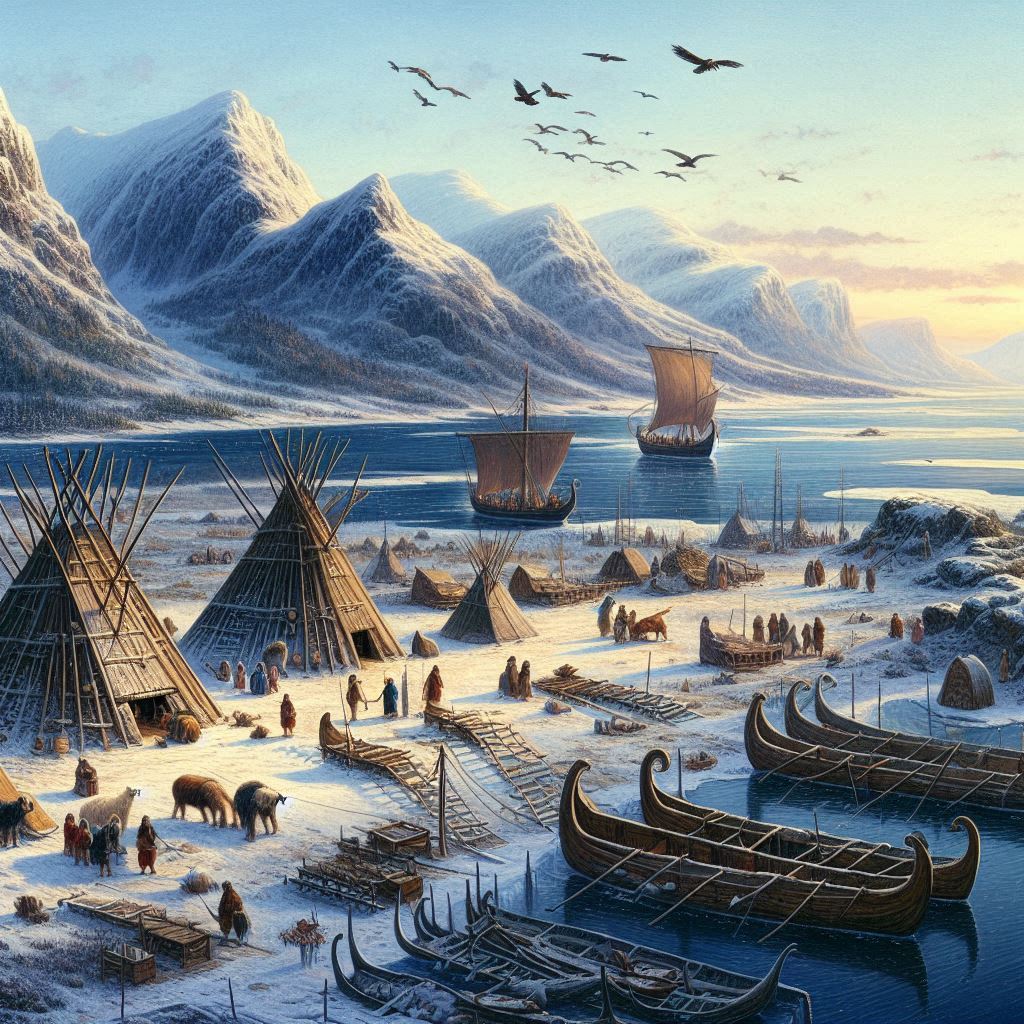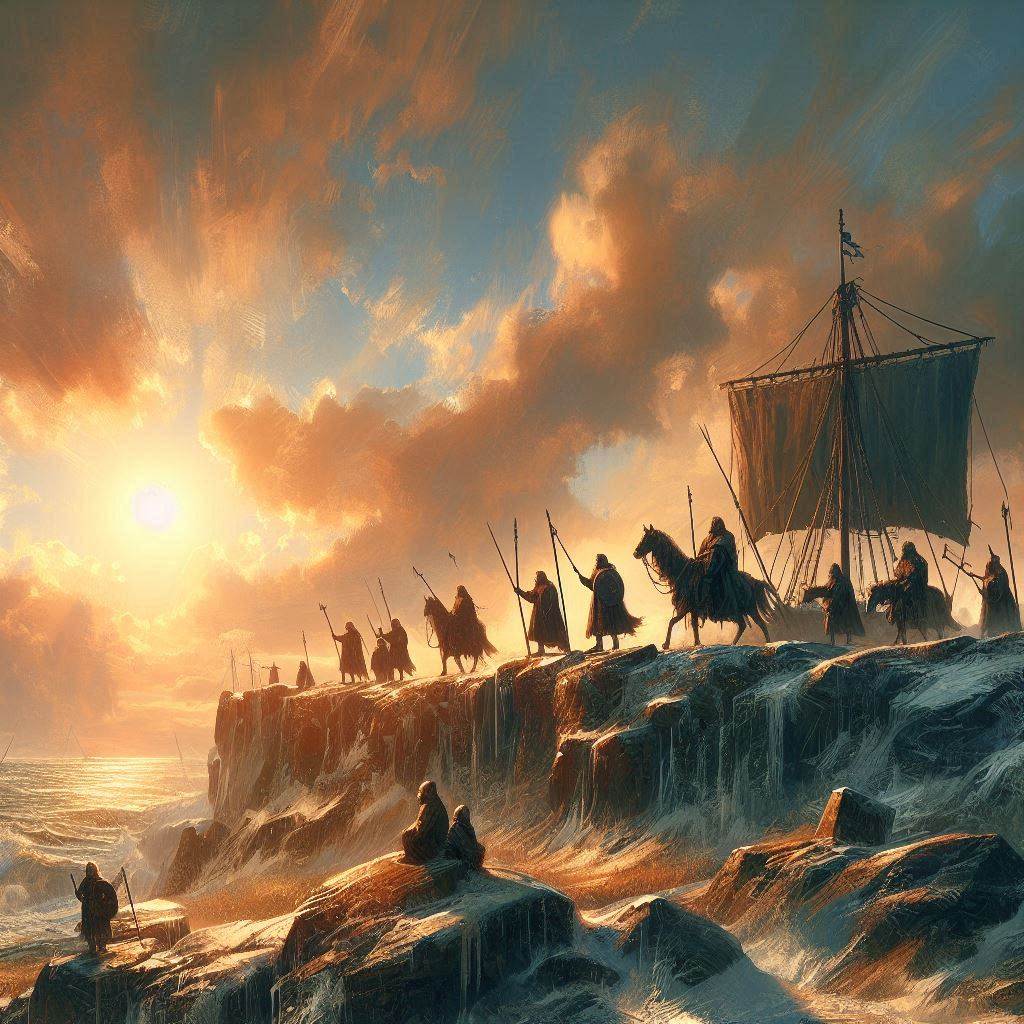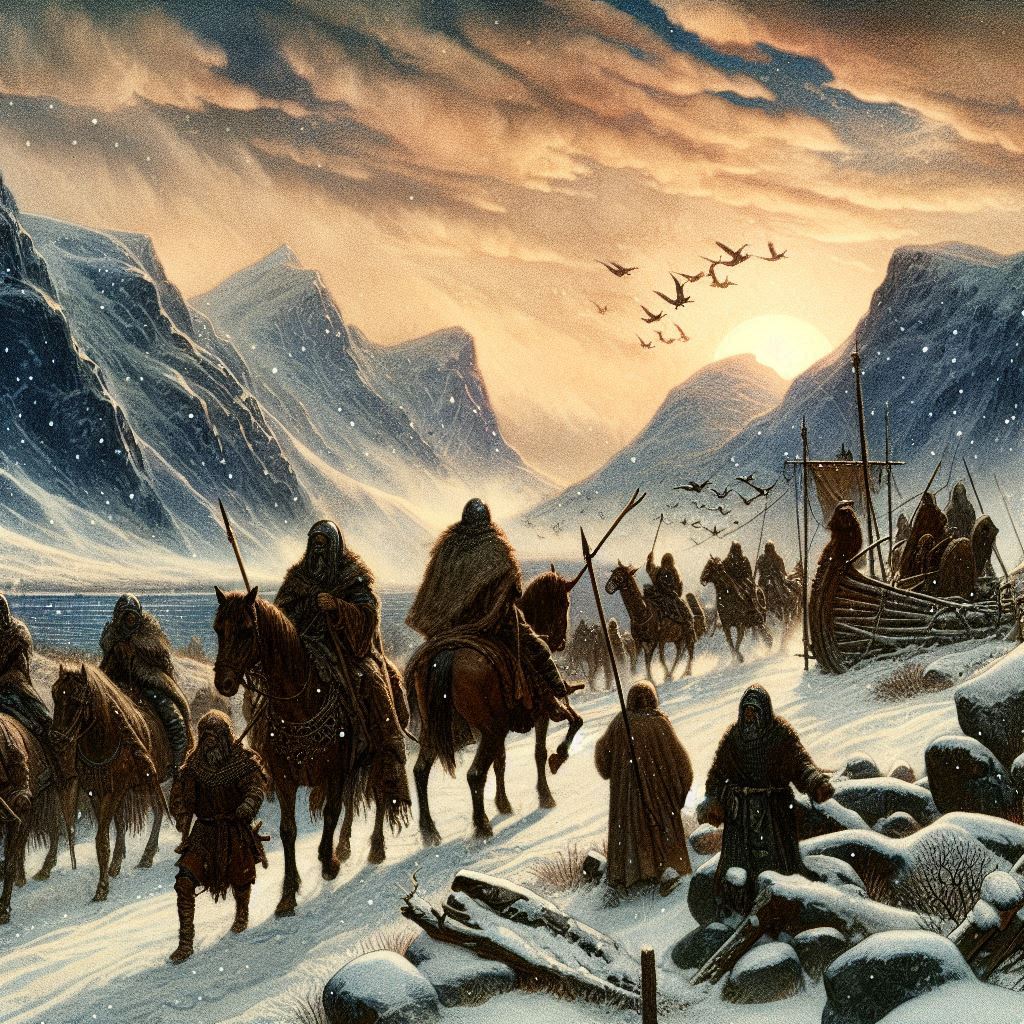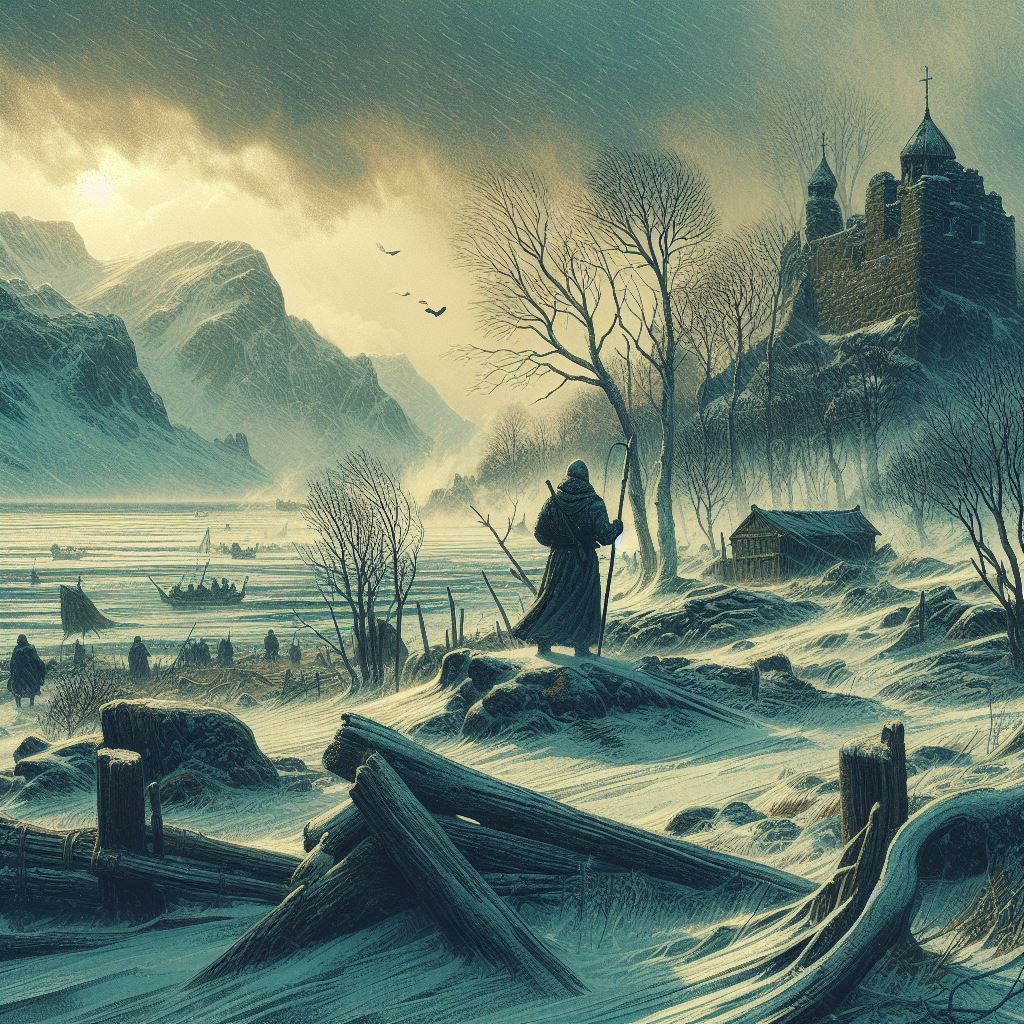Rimster culture
CULTURES SKILLS
- Ambush
- Butchery
- Caving
- Climbing
- Cookery
- Direction Sense
- Fishing
- Foraging
- Grappling Hook
- Hide Item
- Hunting
- Jumping
- Leatherworking
- Man. in Fur
- Man. in S. Leather
- Read Tracks
- Rope Mastery
- Rowing
- Set Traps
- Skiing
- Stalk & Hide
- Tracking
- Trading
- Trap Building
- Weather-Watching
Legend
“Ice flakes, glaciers, windy peaks, and chilling fields have all displayed great heroes.”
Description

Rimster dwellers are hardy, resilient people, adapted to extreme cold and long periods of darkness. Their lives revolve around hunting, fishing, and a strong connection to the environment. Their culture emphasises community, survival, and a deep respect for the natural world around them.
Lifestyle: Most are hunters or fishermen, using their intimate knowledge of the land and sea to sustain their communities. Others may be craftsmen, shamans, or storytellers. Life in these harsh climates necessitates a strong communal bond and a reliance on each member’s skills.
Diet: Rimsters have a diet that is stark and survival-orientated, relying on what little can be found or hunted in cold climates. Their food includes preserved meats, hardy root vegetables, and whatever berries or plants they can gather during the short growing season, and wild game when available. They may also consume fish, seaweed or kelp if they live near coastal areas. Their food is often bland but functional and high in calories to sustain them in cold, harsh environments.
Traditions and Stories: Rimster communities have a rich tradition of storytelling. They pass down epic tales of legendary heroes, spirits of the ice and sea, and the creation of the world. Oral histories and myths are central to their culture, with stories often told around communal fires during the long nights.
Religion: Rimster dwellers practice variations of subdued rituals with some organised cults and shrines. Most have reverence for local or community spirits, although principal worship focusses on the “true gods.”
- Religious system: Nature worship of the deities representing elements or animals.
- God-Mortal Interaction: Belief that spirits inhabit the natural world, including ice and snow and creatures like bears, seals, and whales.
- Rituals: ceremonies to ensure successful hunts, protection from storms, and rites of passage. Honour for those who survived the harsh rimster conditions.
- Impact on Society: A strong sense of community and interdependence. Respect for the natural world is paramount. Religion reinforces the importance of survival skills and knowledge.
Marriage Pattern: Marriages often serve to strengthen alliances within and between tribes. Due to the harsh environment, marriages are practical arrangements with an emphasis on mutual support and survival rather than romantic love.
Skjald Sigurd
Craftsmanship: Their craftsmanship, while seemingly crude, holds a rustic appeal. They produce intricate carvings from bone, ivory, and wood, as well as durable tools and clothing suited for the harsh climate. Items are often decorated with symbols and motifs representing their environment and beliefs.
Clothing & Decoration: They wear various types of elaborate or practical wool and linen garb, including cloaks, boots, and fur-lined tunics. In warmer areas, tunics are common, while shirts, pants, and leggings are worn in cooler locales. They also use animal hides and furs for additional warmth and protection against the elements.
Armor: Rimster dwellers use any type of armour available.
Weapons: Their weapons include composite bows, daggers, javelins, maces, quarterstaffs, and spears.
Special Items: Items, though rustic, has a unique aesthetic appeal. Items are made from materials that may not endure long, such as bronze, copper, tin, leather, yarn, and wood, but are treasured for their craftsmanship and cultural significance.
Skjald Sejrik
Time: Rimster cultures rely on sunshine, auroras, and seasonal ice melt patterns to survive in their harsh environment.
Accomplishment and achievement: Community survival in extreme cold requires mastering ice navigation, sustaining their icy domains, contributing to the collective, and managing resources.
Authority Interaction: Pragmatic, with respect for those who possess critical survival knowledge. Tribal leaders, clan chiefs, and shamans are practical and chosen for their ability to guide their people while respecting the Rim’s old spirits.
Fears & Inabilities: Aside from local superstitions, most fear drowning in tainted waters and becoming draugr (undead).
Mien: Culture strongly shapes demeanour, with limited room for individual expression. Survival often necessitates a strong, community-focused demeanour.
Mannerism: The harsh environment necessitates a practical, aggressive, hard-working, and inquisitive demeanor. Rimster dwellers are often reserved and cautious, but fiercely protective of their community.
Prejudices: Rimster folks are uncomfortable with Mariners and Nobility but welcoming enough to deal with most outsiders. They value practicality and resilience over wealth and status.
Skjald Yell'a'Beard
General Resistance: Their constant exposure to harsh climates has resulted in a strong constitution and resistance to cold-related ailments.
Disease Resistance: Moderate. The cold climate and isolation from large populations reduce the spread of diseases, but they have developed resilience against local pathogens.
Poison Resistance: Moderate. Their diet and environment have exposed them to various natural toxins, building some resistance.
Remedies: They possess extensive knowledge of local plants and natural remedies, using herbs and concoctions to treat ailments and injuries.
Skjald El Mary
History

Rimster cultures often have a history of isolation, leading to the development of unique traditions and beliefs. They might have tales of legendary Rimster spirits or creatures, as well as stories of great heroes who braved the ice and snow. Their history is preserved through oral traditions, with each generation learning the stories and wisdom of their ancestors.
First AgeMany perished in the rather brutal divine hadling of the void gardens used to create the equatorial belt. But they soon adapted to the new world and life under the blistering sun and chilling moon, creating cultures focused upon survival and a semi-nomadic lifestyle.
Second AgeThe 1st Cataclysm changed the lives and cultures of those at the rim, as much as had the creation of the world. The immense energies released, and the thursar twins of the sun and moon’s partial participation, shaken and tilted the very construction of the world.
Third AgeAs the thursar twins far above, displeased with the outcome, disregarded that their paths were off due to the world tilting. The equatorial and tropical climates changed drastically, and the rim became a cold place. Affecting the minds of those residing, their cultures changed further. There were now only a few passages to the southern part of the world, in the massive mountain belt of frost and unmagic.
Fourth AgeIf there had been no passages, our world would have been different, but the wanderers came, dominated, and were misled. So we had the Ljostari sinking and Mt. Vula eruption. As a result of the vular war, the world tilted the more, and the rim closed up. Now it is said to have been crossed only by a few mighty heroes and those of the great invasion originating from down there.
Skjald Ulrich
Cartography

Rimster dwellers generally live in the lowlands between the sea and the mountains, up the foothills, or in fjords suitable for them. They navigate their icy landscapes with expertise, using natural landmarks and celestial bodies to guide them.
Skjald Sigurd
Organisation

Rimster societies are typically small and close-knit, with leadership based on wisdom, hunting skills, or spiritual authority. They have a strong sense of community and cooperation, with each member contributing to the survival and well-being of the group.
Skjald Vinotis
Special

Rimster dwellers possess exceptional survival skills in extreme cold conditions. They have a deep knowledge of Rimster animals and the environment, as well as advanced techniques for hunting and fishing. Their connection to the natural world is reflected in their spiritual beliefs and practices, which emphasise harmony and respect for the forces of nature.
Skjald Ulrich
Last Updated on 2024-10-20 by IoM-Christian
